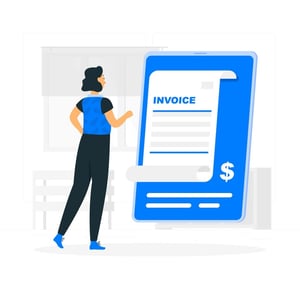As part of a customized business simulation project I am working on, I had the opportunity to interview a group of senior leaders about what they think emerging leaders should know about business acumen. I started the process by getting the usual answers such as, “Understand a P&L,” “Manage Cash Flow,” and “Know how to get a good return on invested capital.”
group of senior leaders about what they think emerging leaders should know about business acumen. I started the process by getting the usual answers such as, “Understand a P&L,” “Manage Cash Flow,” and “Know how to get a good return on invested capital.”
One answer made me smile and think, “I’d like them to know about the anatomy of an invoice.” I’ve been developing business acumen programs for several decades and I’ve never heard this so of course I needed to dive in and ask the SME to further expand.
“I want these emerging leaders to be able to think backward from the sending of an invoice to understand the value map of our company so they know how we work and how we make money. I want them to understand that an invoice isn’t something the Accounting team sends, it’s the representation of the business acumen of our company.”
It was an intriguing idea and one that we were able to quantify for the program. I am pleased to share the highlights of this interesting concept.
The Product / Service
The invoice is the ultimate documentation of the agreement between a business and a customer where the customer is paying for a value proposition. In the value chain of an invoice, this goes beyond the Costs of Goods Sold (COGS). The ultimate value of a product/service is the culmination of R&D to innovate, the know how to design a product, and the Operations team who knows how to actually make the product and get it into the hands of a customer.
In the anatomy of an invoice:
- 25% of the invoice is generated by the R&D to design the product.
- 25% of the invoice is generated by the manufacturing, warehousing, and shipping required to get products to customers.
The Awareness of the Product / Service
The transaction to buy the product /service only happens when customers know the product is available for purchase. This is what Marketing and Sales does and in the value chain of the invoice, these functions play an important role.
Through many different tools, the Marketing team creates awareness for the product / service. These tools include digital marketing, social, print, and other promotional channels related to getting potential and existing customers to buy. The sales teams prospects new clients, follows up and nurtures leads, build relationships, and becomes a trusted advisor to the existing customer.
In the anatomy of the invoice:
- 15% of the invoice is generated by Marketing that creates the awareness.
- 15% of the invoice is generated by the Sales team who is hunting and farming for revenue.
The Infrastructure to Design, Produce, and Sell the Products / Services
Products / services don’t get designed, manufactured, and sold by themselves. Every company has a critical infrastructure in place that supports the operations successfully. This support includes Human Resources that acquires, trains, and retain s talent, the IT functions that keeps the technology running, the Finance department that keeps the business running from the financial perspective, and the administrative functions that pay attention to all the details needed to make it all work.
In the anatomy of the invoice:
- 10% of the invoice is generated by the infrastructure teams that keep the business together and running efficiently.
Now, here’s the fun part. If you add the pieces of the anatomy of the invoice together something interesting happens:
- R&D – 25%
- Operations – 25%
- Marketing – 15%
- Sales - 15%
- Infrastructure – 10%
TOTAL = 90%
Where is the other 10%? Well, that’s the profit! When you think about Business Acumen through the lens of the invoice, you quickly realize that the objective is to deliver the value proposition to the customer in a way that the costs associated with the value proposition are managed so the profit is identified as part of the process.
In summary, this is an interesting and unique way of understanding Business Acumen and it works! Set a target profit and then manage the value chain of the invoice to it.




